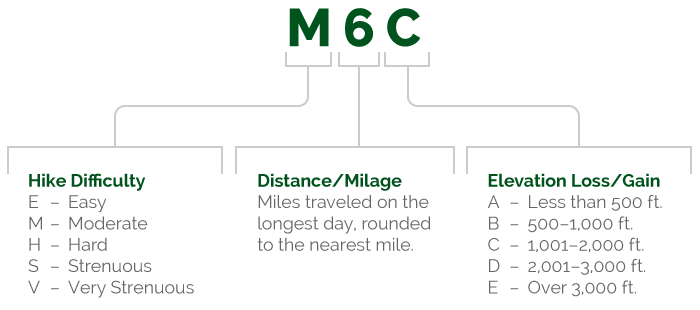
You’ll see that each outing is assigned a three-character code describing the difficulty of the outing.
Hike Difficulty
The first part, a capital letter, refers to the difficulty of the trip. This is a subjective score, but it takes into account things like the pace the leader intends to set, and how difficult the terrain is. Generally, if a car could drive the trail, it will be an E. If you need a 4-wheel drive, it’s at least an M. If no vehicle is going where you are going, it will be an H or above. At this level, you could be using your hands to pull yourself over features, and slipping, well, it could be bad. All of this is subjective. A 20 mile hike, or gaining and losing 4,000 vertical feet, isn’t going to be a moderate hike, even if it’s paved (and even if it’s rated that way.) Also, some leaders grade harder, and some easier. So view the difficulty score as a guide.
| E – Easy | Anyone in reasonable condition can do this trip. |
| M – Moderate | You should be in good shape, but previous hiking experience is not required. |
| H – Hard | Look carefully at the mileage and elevation gain. You should have comfortably done a few moderate trips before attempting this. |
| S – Strenuous | Fast-paced, steep, and challenging. Discuss with the trip leader. |
| V – Very Strenuous | You should be very experienced on strenuous hikes before trying this grade. |
Hike Distance/Mileage
The second part of the code is simply the number of miles, rounded to the nearest mile, traveled on the longest day. So say you hiked 3 miles in on Saturday, set up base camp, then did a 2 mile day hike. On Sunday you did a 5 mile day hike, packed up, then hiked back out the same 3 miles. This hike would get an “8”.
Elevation Loss/Gain
The last letter is a code for the total amount of elevation lost or gained on the most intense day.
A – Less than 500 ft.
B – 500–1,000 ft.
C – 1,001–2,000 ft.
D – 2,001–3,000 ft.
E – Over 3,000 ft.
Example: a grade of “M8C” represents a moderately (M) difficult hike which requires going eight (8) miles on the longest day, and which could climb or descend up to 2,000 ft. (C) in any one day.
